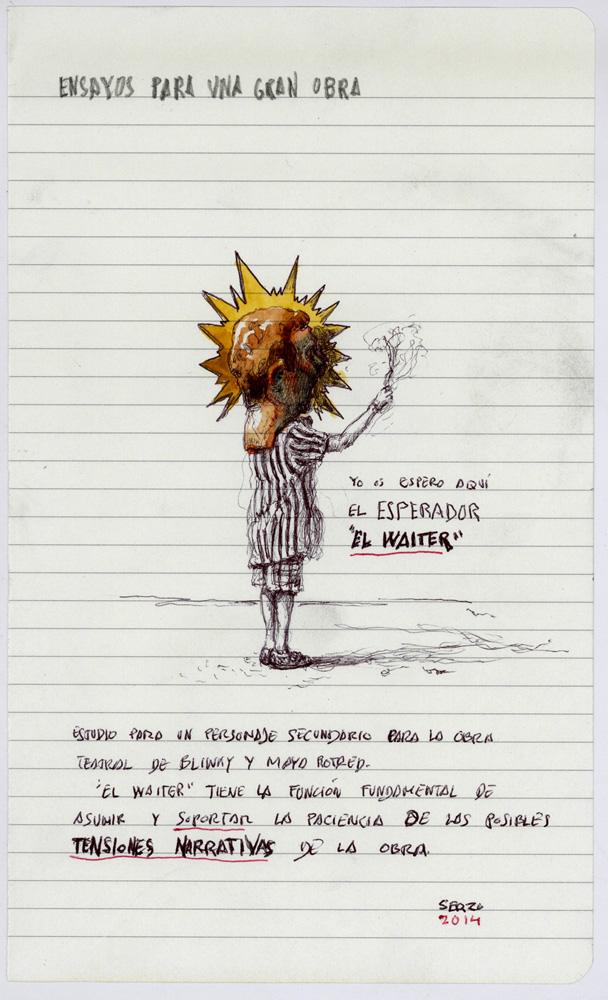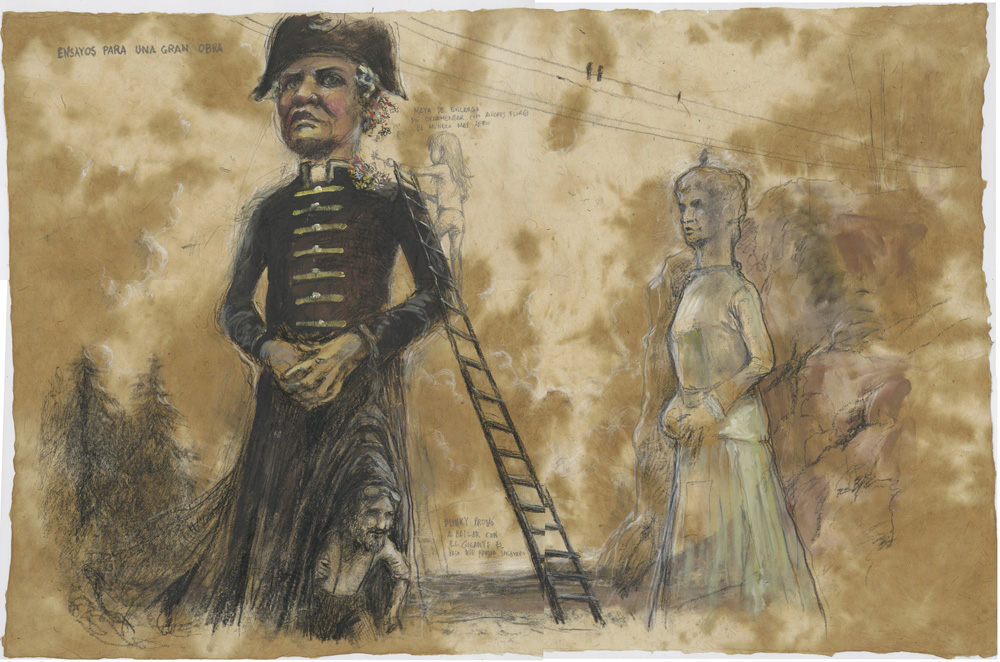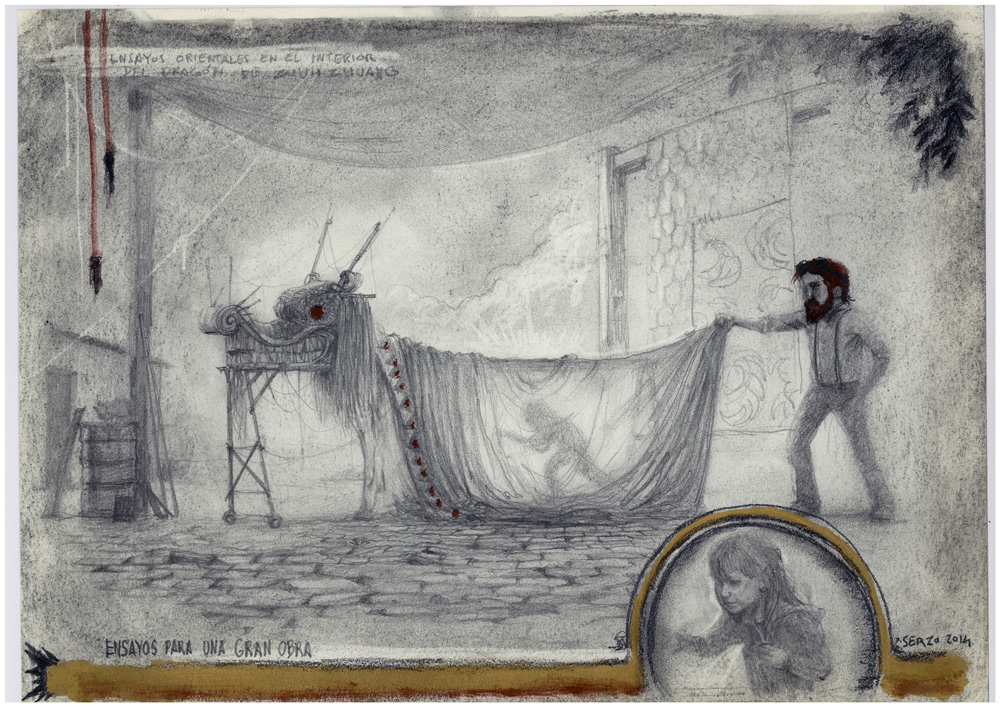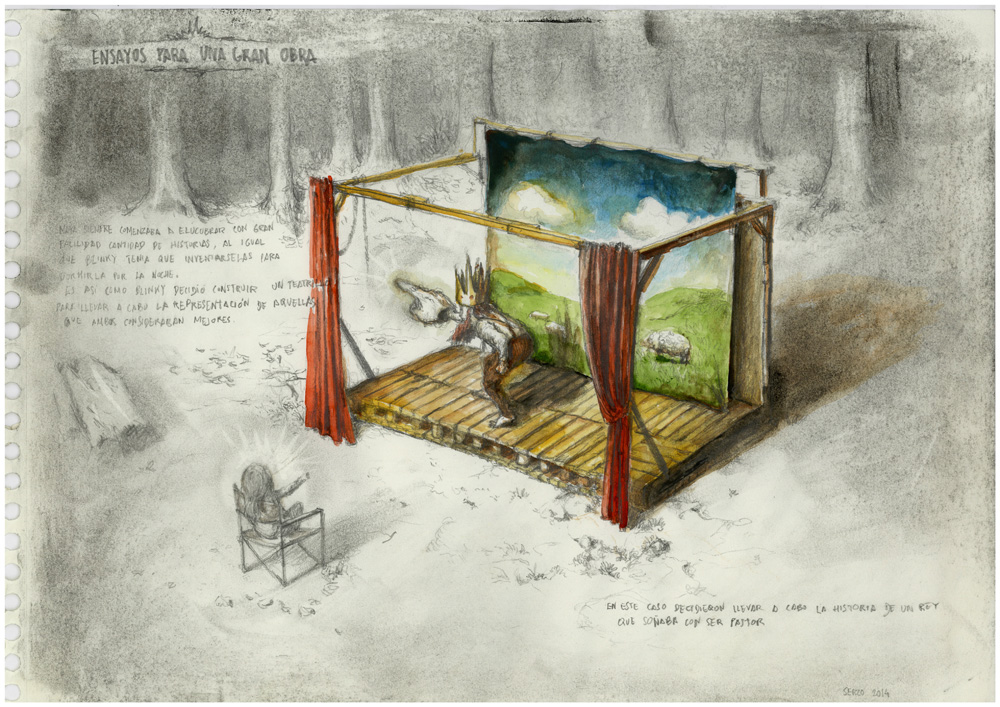

Rehearsals for a great work
2013 - 2014
"Essays for a Great Work" is part of the Conexiones cycle, which is carried out by the ABC Museum and the Fundación Banco Santander
and curated by Óscar Alonso Molina, where artists who maintain close links with drawing are invited to develop a specific work from two works chosen from the collections of both institutions. From his choice, the artist faces each edition with the challenge of revealing those unexpected relationships that give name to the project.
To date, the following have participated in the program: Santiago Morilla, Ornament and Detonation; Juan Carlos Bracho, A Message to Anabel; The Children Pox, The Mystery of the Sun Dog; Nati Bermejo, The Storm; Jesús Zurita, Ida y Trasiego; Amparo Sard, The Other; and Juan López, Severe Ruins.
In this 8th edition of the program Conexiones, José Luis Serzo (Albacete, 1977) presents Ensayos para una gran obra (Essays for a great work), an exhibition project expressly created for the rooms of the ABC Museum, where the artist shows us for the first time in a monographic way a fundamental facet of his work: drawing. Once again, the protagonists of the pieces are Blinky Rotred, the artist’s own alter ego, and his daughter Maya (in fiction and in real life), who we have already seen in many other moments of his work.
In these drawings we see father and daughter engaged in various actions and stories, as they devise models to improve the world. The two invited works are like two spotlights that organize all these scores.
First of all, Ignacio Pinazo’s magnificent oval canvas, entitled Nymphs and Amorcillos (sketch) from 1887, from the Banco Santander Collection, which with its nudes and children, so much to the author’s taste, has given rise to a series of variations by Serzo, among which the large drawings (the largest made by him to date) stand out, transforming Pinazo’s sweet heavenly decorative atmosphere into a precarious plot, with allusions to the genre of the apotheosis and the break-up of Baroque glory.
The origins of the artist, who grew up behind the scenes as the son of the director of the theatre in Casas e Ibáñez (Albacete), are revealed.
At another point in the room appears Sileno’s illustration, loaned by the ABC Collection, originally published in the pages of the newspaper on January 2, 1935, under the title of this year’s El árbol Noel (The Noel Tree), which with its open readings and its conceptual character, so modern, almost visual poetry, immediately caught the artist’s attention. Serzo departs thematically from the childlike mystery of Sileno’s work and stylistically links to Pinazo’s work to create his own discourse.
In today’s contemporary art, Serzo’s case is singular, the mark of theatricalization in his style, in his installations and in his drawings.
The strength of the classics, as in the world of theatre, is present in Serzo’s work, which is reminiscent of Patinir, of the backgrounds of the grand tour travellers, of Pinazo.
The play of light and shadow, the basis of the show and the plot, is also transferred to the illustration of this artist, who creates the depth of field thanks to the play of exaggerated lights like the star or the apotheosis.
His drawing expands beyond the frame of the work (with props or by continuing the drawing on the wall) as his art expands beyond the frame of the painting into the world of classical theatre.
Serzo skillfully handles the showy displays of classical composition, anatomy, foreshortening and the ornamental display of the sets. The aim behind the decoration is to address other, deeper issues: the ethics of our behaviour towards others; the relations between man and the world and conscience as a fundamental tool which, as he says, has been “overpowered by fatherhood, with the appearance of Maya in his life and work”.
In this 8th edition of the program Conexiones, José Luis Serzo (Albacete, 1977) presents Ensayos para una gran obra (Essays for a great work), an exhibition project expressly created for the rooms of the ABC Museum, where the artist shows us for the first time in a monographic way a fundamental facet of his work: drawing. Once again, the protagonists of the pieces are Blinky Rotred, the artist’s own alter ego, and his daughter Maya (in fiction and in real life), who we have already seen in many other moments of his work.
In these drawings we see father and daughter engaged in various actions and stories, as they devise models to improve the world. The two invited works are like two spotlights that organize all these scores.
First of all, Ignacio Pinazo’s magnificent oval canvas, entitled Nymphs and Amorcillos (sketch) from 1887, from the Banco Santander Collection, which with its nudes and children, so much to the author’s taste, has given rise to a series of variations by Serzo, among which the large drawings (the largest made by him to date) stand out, transforming Pinazo’s sweet heavenly decorative atmosphere into a precarious plot, with allusions to the genre of the apotheosis and the break-up of Baroque glory.
The origins of the artist, who grew up behind the scenes as the son of the director of the theatre in Casas e Ibáñez (Albacete), are revealed.
At another point in the room appears Sileno’s illustration, loaned by the ABC Collection, originally published in the pages of the newspaper on January 2, 1935, under the title of this year’s El árbol Noel (The Noel Tree), which with its open readings and its conceptual character, so modern, almost visual poetry, immediately caught the artist’s attention. Serzo departs thematically from the childlike mystery of Sileno’s work and stylistically links to Pinazo’s work to create his own discourse.
In today’s contemporary art, Serzo’s case is singular, the mark of theatricalization in his style, in his installations and in his drawings.
The strength of the classics, as in the world of theatre, is present in Serzo’s work, which is reminiscent of Patinir, of the backgrounds of the grand tour travellers, of Pinazo.
The play of light and shadow, the basis of the show and the plot, is also transferred to the illustration of this artist, who creates the depth of field thanks to the play of exaggerated lights like the star or the apotheosis.
His drawing expands beyond the frame of the work (with props or by continuing the drawing on the wall) as his art expands beyond the frame of the painting into the world of classical theatre.
Serzo skillfully handles the showy displays of classical composition, anatomy, foreshortening and the ornamental display of the sets. The aim behind the decoration is to address other, deeper issues: the ethics of our behaviour towards others; the relations between man and the world and conscience as a fundamental tool which, as he says, has been “overpowered by fatherhood, with the appearance of Maya in his life and work”.
- All
- Exhibitions
- Work


The Golden Shadow

Rehearsals under the table

Desktop games

The throne for a shepherd king

The slash

As if it were a great advent

The Expecter, The Waiter

Blinky and the intrepid balancing game with twelve rattlesnakes

Two giants for the third act

Blinky rescuing old costumes

They discussed who would play Tintoretto

Blinky showing one of her latest inventions to Maya

With chinese shadows

Opening-Overture (with a small pointer)

Blinky and Maya in the workshop

Appearance of a THEWELCOME coat for Maya in Blinky’s mind

Embarcadero Palace

ABC Museum

The treasures of the boxes

Oriental rehearsals inside the dragon

Maya decorating a giant for the third act

Essays for a great work (on Maya’s table)

Maya elucubrating the first act with a producer of optimism

Rehearsals for a great work I

Project for a facility

Maya rehearsed part of the third act while the rest of the group rested

Essays for a Great Work II

Studies for an optimism producer (for a third act)

A strange choreography

Stories of a shepherd king

Costume for The Visitor

Juan de Mata was frantic in his new role

